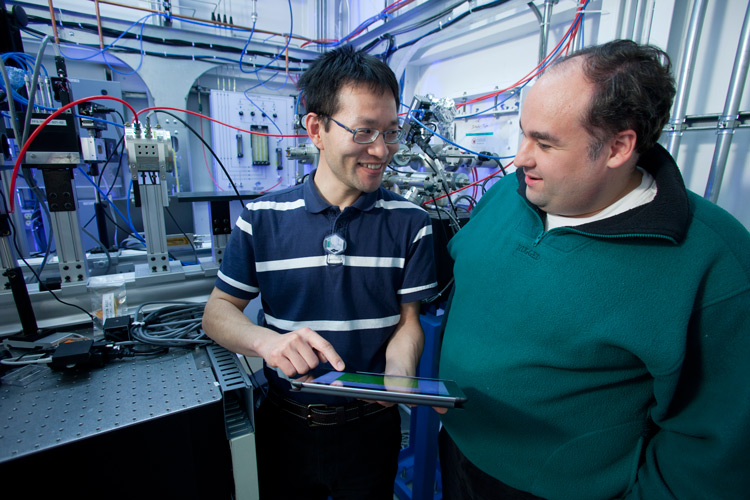U of S researchers create link between Brazilian and Canadian synchrotrons
Use of advanced internet technology to bring scientists and leading-edge research infrastructure together half a world apart has been demonstrated between the national synchrotron facilities of Canada and Brazil.
By Mark Ferguson The demonstration in Brazil, observed by Canadian Governor General David Johnston and Dr. Antônio José Roque da Silva, Director of the Brazilian Synchrotron Light Laboratory (LNLS), made use of remote control software developed at the Canadian Light Source (CLS) synchrotron in Saskatoon to access a CLS beamline and collect data from a computer at a research station in the LNLS.
The demonstration in Brazil, observed by Canadian Governor General David Johnston and Dr. Antônio José Roque da Silva, Director of the Brazilian Synchrotron Light Laboratory (LNLS), made use of remote control software developed at the Canadian Light Source (CLS) synchrotron in Saskatoon to access a CLS beamline and collect data from a computer at a research station in the LNLS.The experiment was initiated from Brazil by Peter MacKinnon, president of the University of Saskatchewan which is home to the CLS. The demonstration involved accessing the VESPERS beamline at the CLS from a computer at the LNLS and taking a series of scans of a tissue sample of Crohn's Disease, including starting the experimental scans and receiving the resulting data.
"This is an amazing example of the new opportunities for research and collaboration available to scientists and graduate students both in Canada and Brazil thanks to this innovative technology developed at the CLS," said MacKinnon. "It provides a powerful way for researchers at Canadian universities such as the University of Saskatchewan to exchange ideas and information in real time with colleagues around the world, thereby maximizing public investment in science facilities like the CLS."
Another demonstration had Canadian and Argentinian researchers performing an experiment at the LNLS using LabWeb, the Brazilian remote access project that uses the new CLS-developed technology. In the same way, scientists located in their lab or office at a university in Brazil, for example, can access the CLS to run experiments directly or collaborate with Canadian researchers and students.
"This project opens a new frontier in scientific research since scientists can perform experiments from anywhere in the world, not only at the place where the laboratory is located," points out Roque. "This is indeed the concrete realization of the concept of cooperation. From now on, researchers from Canada, Brazil and other countries will be able to exchange their expertise and knowledge working together in real time. This is a big step to improve the collaborative science."
The CLS software innovation, funded by Canada's CANARIE Network Enabled Program, has led to a suite of web-based applications called ScienceStudio that involves the University of Western Ontario, Concordia University, and IBM Canada.
"ScienceStudio is the result of the kind of innovation that can happen when partners from major science facilities, universities and industries work together," notes CLS Executive Director Josef Hormes. "The Canadian Light Source and the Brazilian Synchrotron Light Laboratory are collaborating on a number of exciting projects that will benefit both of our country's scientific communities."
Using ScienceStudio, research groups can securely access and run experiments at ‘big science' research facilities such as the CLS, collect data, collaborate on data analysis and interpretation of results, and schedule additional experiments. Currently, ScienceStudio is in use on a beamline at the CLS, the Nanofabrication Facility at the University of Western Ontario, and the Advanced Light Source in Berkeley, California, as well as at the LNLS and Cenpes/Petrobras, an associated research centre in Brazil.
ScienceStudio and LabWeb are examples of joint projects undertaken by the two synchrotrons as the result of a memorandum of understanding signed in 2008. Another example is the collaborative development of the Brockhouse X-ray Diffraction and Scattering Sector beamlines at the CLS.
For more information, visit the
Canadian Light Source website.

